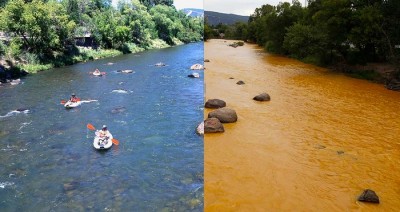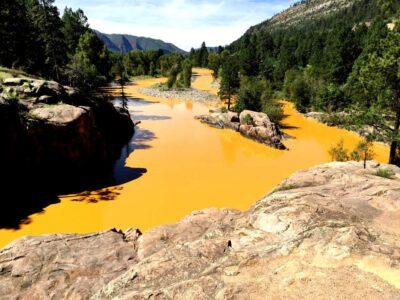The Environmental Protection Agency is responsible for a spreading environmental disaster that is threatening crucial waterways throughout the Southwest.
The catastrophe has contaminated rivers in Colorado and New Mexico with up to 3 million gallons of orange sludge containing lead, arsenic, cadmium and other toxic metals.
One sample showed the lead level an astonishing 12,000 times the acceptable standard [2] – standards set by the EPA. Mercury was 10 times the acceptable level, beryllium and cadmium 33 times, and arson 800 times.
“The magnitude of it, you can’t even describe it,” New Mexico Governor Susana Martinez said. “It’s like when I flew over the fires, your mind sees something it’s not ready or adjusted to see.”
Martinez was referencing a wave of orange toxic sludge that’s moving down the Animas River in the southwestern part of the state.
The sludge [3] could eventually spread as far as Lake Powell and the Colorado River, which is the main source of water for Las Vegas, Southern California and Arizona, The Los Angeles Times reported. It could also reach the Grand Canyon and Lake Meade.
How the EPA Created a Tragedy
“I’m very sorry,” EPA director of emergency preparedness, David Ostrander, told a crowd in Durango, Colorado. “This is a huge tragedy.”
Durango is one of several communities already affected by the sludge. The tourist town’s economy is threatened because the Animas River [5] is used for such activities as river rafting, kayaking, swimming and trout fishing.
The tragedy began on Wednesday, August 5, when EPA investigators broke open a dam at the abandoned Gold King Mine near Silverton, Colorado, The Denver Post reported. That caused 3 million gallons of contaminated water to start spilling into Cement Creek, which runs into the Animas River.
By Saturday, the toxic water had reached Farmington, New Mexico, around 100 miles to the South. At Farmington, the Animas runs into the San Juan River, which eventually flows into Lake Powell, in Utah. Lake Powell, a reservoir, is a popular recreation area on the Colorado River. On Monday it already had reached the Utah border.
“It looks awful, it looks disgusting. I wouldn’t stay anywhere near the river,” Farmington bartender Jared L. McComas told The LA Times. “Every one of my customers that comes in, I tell them not to go.”
The Tragedy’s Effects So Far
Southwestern Colorado residents who rely on wells were told not to use water for bathing, drinking and cooking until it is tested for heavy metals. A property owner near Durango reported that water in a well was turning yellow.
County officials have closed the Animas for recreation use in La Plata County.
The Animas River is the main source of water for the cities of Durango, Colorado, and Farmington and Aztec in New Mexico.
The Navajo Nation, the country’s largest Native American community which is located just outside of Farmington, is planning to sue the EPA over the spill [7].
“They are not going to get away with this,” Navajo Nation President Russell Begaye told Fox News. “The EPA was right in the middle of the disaster and we intend to make sure the Navajo Nation recovers every dollar it spends cleaning up this mess and every dollar it loses as a result of injuries to our precious Navajo natural resources.
Some residents of Durango shared Begaye’s outrage.
“There is usually wave after wave of people floating past, but today nothing,” Sairi Dwyer told The Los Angeles Times. “The EPA causes all of this and then they say, ‘Oh well’ and nothing happens. If you or I did this or anything close we’d be in jail.”
Rafting company owner Alex Mickel estimated he would lose $150,000 in revenue this month.
“The EPA failed to follow their own procedures — they admitted it. Now they need to help out the community economically,” Mickel said.
The problem is likely long-term, simply because heavy metals will settle on the bottom of the river, Shaun McGrath, the administrator for EPA’s Region 8, told Fox News.
What do you believe the EPA should do for the local communities? Share your thoughts on the section below:


